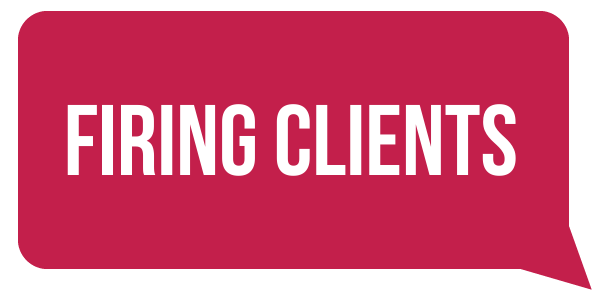
You’re not allowed to claim favorites among your children, but you are allowed to have favorites among your clients. Conversely, you’re also allowed to identify problem-clients on a variety of metrics and fire them. In fact, firing clients is a delicate but necessary part of running a sustainable business. But wait! Just like your children need your guidance on how to improve their behavior, your clients can benefit from feedback and time to change their ways. Curating your client load can lead to greater profitability, improved reputation within the industries you serve, and long-term relationships between satisfied employees and happy clients. However you envision the future of your firm, when done the right way, firing clients can help you achieve it. Here’s how to do it.
Grade Your Clients
You’ve definitely heard the idea of grading clients before. However, don’t just grade and cut everyone below the line. You have relationships with those people (some of them for decades!), and it can be emotionally hard to fire them. It’s still a healthy exercise to grade your clients, and you may even be able to retrain some of them, allowing you to continue working together. So, once you have your list, think about what isn't working about the business relationship. Not paying enough? (that’s probably the firm's fault, by the way) Not prepared? Slow to pay invoices? Messy bookkeeping? Not in a niche/industry specialty? (OK, that’s black-belt level, but hey, #lifegoals!) They don't tell you about problems proactively, so it's more work to clean it up later? Someone is consistently rude or mistreats your employees? (some relationships are not salvageable - keep reading) If you want some help determining your criteria, see our recent article Finding and Serving Desirable New Clients.
Guide Clients To Improve Their Grades
Once you have your list of clients and have thought about WHY they’re on the list, consider how the “D” relationship can be revived into a “B” or “A” grade. What would it take to correct the issue you identified in the previous step? For example, if they are not paying even close to market rates, suggest they go out to bid for their work so that they can see the current market rates. This will make it easier for them to agree to pay you higher rates if they wish to continue working together, getting them off the “D” list! Or, if they insist on maintaining their current spending level, they may be able to find a firm happy to serve them at that rate - but the bidding process will help them feel like they’re part of the decision to switch. Perhaps there is a middle ground where some work is done by a smaller shop, but you continue to provide advisory work. Approach your list with the mindset that there is an amicable way for both parties to move forward.
When Clients Don’t Make the Cut
With some clients, even after attempting to bring them along in the firm’s new direction, you will discover you have outgrown the relationship. (Maybe we call this the “F” list?) Have a heartfelt, candid conversation about how your firm is not handling clients of their size anymore and as much as it pains you, you have to part ways. It can be helpful to have someone else from the firm attend the meeting with you to bolster the conversation. It won't be fun, but it will be better for everyone in the long run. Help the client make a plan for how to find a new provider and assure them that you’ll make the transition as easy as possible.
When You Should ALWAYS Fire a Client
If the client is treating your team like crap, they’ve gotta go. If you don’t already have one, develop a code of conduct that both clients and staff agree to, and you will never have to think twice about what constitutes inappropriate behavior or what to do when it occurs. Protecting your team is a critical part of diversity, equity and inclusion policies, and codifying what the firm tolerates goes hand-in-hand with attracting and retaining both happy clients and happy employees. Today, as firms face notable hiring and retention challenges, ensuring your client base is comprised of preferred clients is even more important. Employees and job seeking professionals want to work with quality clients who are engaged in the relationship and treat them and others with respect.
Conclusion
Yes, you probably need to fire some clients in order to meet your goals and keep your team from burning-out. If you can frame it as a sign of growth and thoughtfully consider a path forward with each client who doesn’t make the grade, your firm will benefit in the end, and your conscience will be clear. Need some determining which clients should stay or go? Contact me today.





